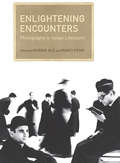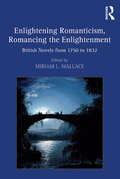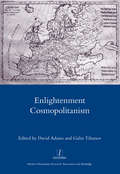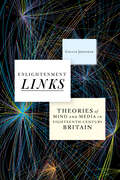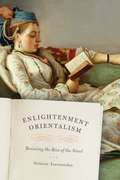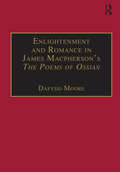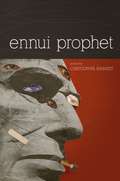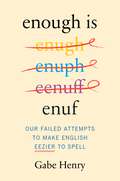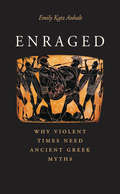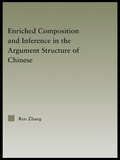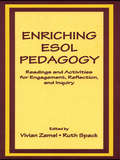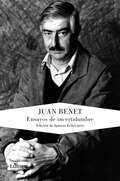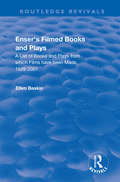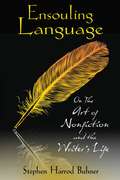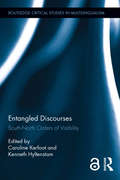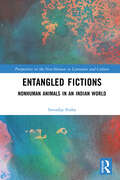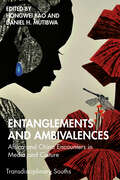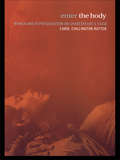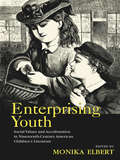- Table View
- List View
Enlightening Encounters
by Giorgia Alu Nancy PedriEnlightening Encounters traces the impact of photography on Italian literature from the medium's invention in 1839 to the present day. Investigating the ways in which Italian literature has responded to photographic practice and aesthetics, the contributors use a wide range of theoretical perspectives to examine a variety of canonical and non-canonical authors and a broad selection of literary genres, including fiction, autobiography, photo-texts, and migration literature. The first collection in English to focus on photography's reciprocal relationship to Italian literature, Enlightening Encounters represents an important resource for a number of fields, including Italian studies, literary studies, visual studies, and cultural studies.
Enlightening Romanticism, Romancing the Enlightenment: British Novels from 1750 to 1832
by Miriam L. WallaceAs eighteenth-century scholarship expands its range, and disciplinary boundaries such as Enlightenment and Romanticism are challenged, novels published during the rich period from 1750 to 1832 have become a contested site of critical overlap. In this volume, scholars who typically write under the rubric of either the long eighteenth century or Romanticism examine novels often claimed by both scholarly periods. This shared enterprise opens new and rich discussions of novels and novelistic concerns by creating dialogue across scholarly boundaries. Dominant narratives, critical approaches, and methodological assumptions differ in important ways, but these differences reveal a productive tension. Among the issues engaged are the eighteenth-century novel's development of emotional interiority, including theories of melancholia; the troubling heritage of the epistolary novel for the 1790s radical novel; tensions between rationality and romantic affect; issues of aesthetics and politics; and constructions of gender, genre, and race. Rather than positing a simple opposition between an eighteenth-century Enlightenment of rationality, propriety, and progress and a Romantic Period of inspiration, heroic individualism, and sublime emotionality, these essays trace the putatively 'Romantic' in the early 1700s as well as the long legacy of 'Enlightenment' values and ideas well into the nineteenth century. The volume concludes with responses from Patricia Meyer Spacks and Stephen C. Behrendt, who situate the essays and elaborate on the stakes.
Enlightenment Cosmopolitanism
by David AdamsEnlightenment Cosmopolitanism brings together ten innovative contributions by outstanding scholars working across a wide array of disciplines in the humanities and social sciences. Interdisciplinary in its methodology and compass, with a strong comparative European dimension, the volume examines discourses ranging from literature, historiography, music and opera to anthropology and political philosophy. It makes an original contribution to the study of 18th-century ideas of universal peace, progress and wealth as the foundation of future debates on cosmopolitanism. At the same time, it analyses examples of counter-reaction to these ideas and discusses the relevance of the Enlightenment for subsequent polemics on cosmopolitanism, including 21st-century debates in sociology, politics and legal theory.
Enlightenment Links: Theories of Mind and Media in Eighteenth-Century Britain (Stanford Text Technologies)
by Collin JenningsIn this ambitious work, Collin Jennings applies computational methods to eighteenth-century fiction, history, and poetry to reveal the nonlinear courses of reading they produce. Hallmark genres of the British Enlightenment, such as the novel and the stadial history, are typically viewed as narratives of linear progress, emerging from Britain's imperial growth and scientific advancement. Jennings foregrounds Enlightenment links: the paratextual devices, including cross-references, footnotes, and epigraphs, that make words work differently by pointing the reader to places inside and outside the text. Writers and printers combined text and paratext to produce nonlinear paths of reading and polysemous forms of reference that resist simple, causal structures of experience or theories of mind. Alexander Pope, Adam Smith, Ann Radcliffe, and other writers developed genres that operate diagrammatically, with different points of entry and varied relationships between the language and format of books. Revealing the eighteenth-century genealogy of the digital hyperlinks of today, Enlightenment Links argues that emergent print genres combined language and links to bring forward the associative, circular, and multi-sequential ways in which literature makes language work.
Enlightenment Orientalism: Resisting the Rise of the Novel
by Srinivas AravamudanSrinivas Aravamudan here reveals how Oriental tales, pseudo-ethnographies, sexual fantasies, and political satires took Europe by storm during the eighteenth century. Naming this body of fiction Enlightenment Orientalism, he poses a range of urgent questions that uncovers the interdependence of Oriental tales and domestic fiction, thereby challenging standard scholarly narratives about the rise of the novel.More than mere exoticism, Oriental tales fascinated ordinary readers as well as intellectuals, taking the fancy of philosophers such as Voltaire, Montesquieu, and Diderot in France, and writers such as Defoe, Swift, and Goldsmith in Britain. Aravamudan shows that Enlightenment Orientalism was a significant movement that criticized irrational European practices even while sympathetically bridging differences among civilizations. A sophisticated reinterpretation of the history of the novel, Enlightenment Orientalism is sure to be welcomed as a landmark work in eighteenth-century studies.
Enlightenment and Romance in James Macpherson’s The Poems of Ossian: Myth, Genre and Cultural Change (Studies in Early Modern English Literature)
by Dafydd MooreThis study examines the relationship between Enlightenment and romance through the work of James Macpherson and in particular his The Poems of Ossian. By re-reading Macpherson's work in ways not restricted by the sterile and by now largely settled debates over authenticity, Moore establishes Ossian's credentials to be considered as romance, in its manner of construction, its represented sensibility, and in its engagement with the potentialities and limitations of eighteenth-century discourses of sympathy and society. An increasing amount has been written on Macpherson over the last ten or so years, and at last it seems possible to talk about The Poems of Ossian without reference to questions of authenticity or charges of forgery. Yet the polarised debate over the authenticity of the Poems has been superseded by equally polarised arguments about such matters as the cultural significance and politics of Ossian, arguments in which the poems have been used as a convenient peg on which to hang various, often predetermined, positions. Fresh and groundbreaking, this study recentres Ossian revisionism by providing an account of a series of works increasingly talked about, but still little read or understood.
Enlightenment in the Colony: The Jewish Question and the Crisis of Postcolonial Culture
by Aamir R. MuftiEnlightenment in the Colony opens up the history of the "Jewish question" for the first time to a broader discussion--one of the social exclusion of religious and cultural minorities in modern times, and in particular the crisis of Muslim identity in modern India. Aamir Mufti identifies the Hindu-Muslim conflict in India as a colonial variation of what he calls "the exemplary crisis of minority"--Jewishness in Europe. He shows how the emergence of this conflict in the late nineteenth century represented an early instance of the reinscription of the "Jewish question" in a non-Western society undergoing modernization under colonial rule. In so doing, he charts one particular route by which this European phenomenon linked to nation-states takes on a global significance. Mufti examines the literary dimensions of this crisis of identity through close readings of canonical texts of modern Western--mostly British-literature, as well as major works of modern Indian literature in Urdu and English. He argues that the one characteristic shared by all emerging national cultures since the nineteenth century is the minoritization of some social and cultural fragment of the population, and that national belonging and minority separatism go hand in hand with modernization. Enlightenment in the Colony calls for the adoption of secular, minority, and exilic perspectives in criticism and intellectual life as a means to critique the very forms of marginalization that give rise to the uniquely powerful minority voice in world literatures.
Ennius and the Architecture of the Annales
by Jackie ElliottEnnius' Annales, which is preserved only in fragments, was hugely influential on Roman literature and culture. This book explores the genesis, in the ancient sources for Ennius' epic and in modern scholarship, of the accounts of the Annales with which we operate today. A series of appendices detail each source's contribution to our record of the poem, and are used to consider how the interests and working methods of the principal sources shape the modern view of the poem and to re-examine the limits imposed and the possibilities offered by this ancient evidence. Dr Elliott challenges standard views of the poem, such as its use of time and the disposition of the gods within it. She argues that the manifest impact of the Annales on the collective Roman psyche results from its innovative promotion of a vision of Rome as the primary focus of the cosmos in all its aspects.
Ennui Prophet
by Christopher Kennedy"Singular and deeply pleasurable. Christopher Kennedy's prosetry is a lonely anarchic nation-state unto itself, half vacation funspot, half eerie purgatorial layover."-Dave EggersThe poems in Ennui Prophet, Christopher Kennedy's fourth collection, range from deeply personal explorations of relationships with family and friends, to examinations of the political climate in the first decade of the millennium. Whether personal or public, Kennedy gazes through a slightly distorted lens to better see the world around us.Christopher Kennedy's previous book, Encouragement for a Man Falling to His Death (BOA Editions Ltd., 2007) received the Isabella Gardner Poetry Award. He directs Syracuse University's MFA program in creative writing.
Ennui Prophet (American Poets Continuum #127)
by Christopher Kennedy"Singular and deeply pleasurable. Christopher Kennedy's prosetry is a lonely anarchic nation-state unto itself, half vacation funspot, half eerie purgatorial layover."-Dave EggersThe poems in Ennui Prophet, Christopher Kennedy's fourth collection, range from deeply personal explorations of relationships with family and friends, to examinations of the political climate in the first decade of the millennium. Whether personal or public, Kennedy gazes through a slightly distorted lens to better see the world around us.Christopher Kennedy's previous book, Encouragement for a Man Falling to His Death (BOA Editions Ltd., 2007) received the Isabella Gardner Poetry Award. He directs Syracuse University's MFA program in creative writing.
Enough Is Enuf: Our Failed Attempts to Make English Easier to Spell
by Gabe HenryA brief and humorous 500-year history of the Simplified Spelling Movement from advocates like Ben Franklin, C. S. Lewis, and Mark Twain to texts and Twitter.Why does the G in George sound different from the G in gorge? Why does C begin both case and cease? And why is it funny when a philologist faints, but not polight to laf about it? Anyone who has ever had the misfortune to write in English has, at one time or another, struggled with its spelling.So why do we continue to use it? If our system of writing words is so tragically inconsistent, why haven’t we standardized it, phoneticized it, brought it into line? How many brave linguists have ever had the courage to state, in a declaration of phonetic revolt: “Enough is enuf”? The answer: many. In the comic annals of linguistic history, legions of rebel wordsmiths have died on the hill of spelling reform, risking their reputations to bring English into the realm of the rational. This book is about them: Mark Twain, Ben Franklin, Eliza Burnz, C. S. Lewis, George Bernard Shaw, Charles Darwin, and the innumerable others on both sides of the Atlantic who, for a time in their life, became fanatically occupied with writing thru instead of through, tho for though, laf for laugh, beleev for believe, and dawter for daughter (and tried futilely to get everyone around them to do it too). Henry takes his humorous and informative chronicle right up to today as the language seems to naturally be simplifying to fit the needs of our changing world thanks to technology—from texting to Twitter and emojis, the Simplified Spelling Movement may finally be having its day.
Enough Said: What's Gone Wrong with the Language of Politics?
by Mark ThompsonThere’s a crisis of trust in politics across the western world. Public anger is rising and faith in conventional political leaders and parties is falling. Anti-politics, and the anti-politicians, have arrived. In Enough Said, President and CEO of The New York Times Company Mark Thompson argues that one of the most significant causes of the crisis is the way our public language has changed. Enough Said tells the story of how we got from the language of FDR and Churchill to that of Donald Trump. It forensically examines the public language we’ve been left with: compressed, immediate, sometimes brilliantly impactful, but robbed of most of its explanatory power. It studies the rhetoric of western leaders from Reagan and Thatcher to Berlesconi, Blair, and today’s political elites on both sides of the Atlantic. And it charts how a changing public language has interacted with real world events – Iraq, the financial crash, the UK's surprising Brexit from the EU, immigration – and led to a mutual breakdown of trust between politicians and journalists, to leave ordinary citizens suspicious, bitter, and increasingly unwilling to believe anybody. Drawing from classical as well as contemporary examples and ranging across politics, business, science, technology, and the arts, Enough Said is a smart and shrewd look at the erosion of language by an author uniquely placed to measure its consequences.
Enraged: Why Violent Times Need Ancient Greek Myths
by Emily Katz Anhalt&“Anhalt&’s contribution is building an overarching narrative of how the Greeks engaged problems of anger—problems that continue to provoke.&”—Choice Millennia ago, Greek myths exposed the dangers of violent rage and the need for empathy and self-restraint. Homer&’s Iliad, Euripides&’ Hecuba, and Sophocles&’ Ajax show that anger and vengeance destroy perpetrators and victims alike. Composed before and during the ancient Greeks&’ groundbreaking movement away from autocracy toward more inclusive political participation, these stories offer guidelines for modern efforts to create and maintain civil societies. Emily Katz Anhalt reveals how these three masterworks of classical Greek literature can teach us, as they taught the ancient Greeks, to recognize violent revenge as a marker of illogical thinking and poor leadership. These time-honored texts emphasize the costs of our dangerous penchant for glorifying violent rage and those who would indulge in it. By promoting compassion, rational thought, and debate, Greek myths help to arm us against the tyrants we might serve and the tyrants we might become. &“An engaging and sometimes inspiring guide to the rich complexities of the Iliad . . . Her underlying point is that, from its earliest origins, Western literature questioned the values of the society that produced it.&”—The New York Times Book Review &“Anhalt has taken on three of history&’s most important works of literature and applied their lessons to the present day. Enraged is an important reminder that reflection, dialogue, and empathy have no boundaries or time limits.&”—Amanda Foreman, Whitbread Prize-winning author of Georgiana: Duchess of Devonshire &“[Anhalt&’s study is] rewarding and unnerving . . . A call to arms.&”—Bryn Mawr Classical Review
Enriched Composition and Inference in the Argument Structure of Chinese (Outstanding Dissertations in Linguistics)
by Ren ZhangAs with many other languages, Mandarin Chinese exhibits a rich variety of ways in expressing the arguments of the predicator in a sentence. Unlike other languages, such variation is typically devoid of any formal marking. Previous attempts in explaining such phenomena usually focus on the syntax as an explanatory tool. This book argues that a large majority of such argument structure phenomena are better accounted for by recourse to enriched representations in lexical semantics. Drawing insights from conceptual semantics, cognitive semantics, Generative Lexicon, construction grammar and formal syntax, this book constitutes the first attempt at a comprehensive account of lexical semantic issues in Mandarin Chinese.
Enriching Esol Pedagogy: Readings and Activities for Engagement, Reflection, and Inquiry
by Ruth Spack Vivian ZamelEnriching ESOL Pedagogy: Readings and Activities for Engagement, Reflection, and Inquiry is a collection of thought-provoking articles and activities designed to engage practicing and prospective ESOL teachers in an ongoing process of reflecting on, critically examining, and investigating theory and practice. Its twofold purpose is to provide a theoretical perspective and to offer ways for making the teaching of English to speakers of other languages (ESOL) meaningful for both teachers and learners. Underlying the activities and the readings themselves is the assumption that teachers need to play a role in exploring, shaping, and theorizing the work they do. The readings included represent a range of genres. They are informed by a common philosophical perspective about language acquisition and treat language teaching and learning holistically. The book is organized into five integrated units that: * raise questions about conventional notions of methods; * take into account the complicated nature of real classrooms; * provide theoretical principles for teaching that promotes language acquisition; * include rich descriptions of actual classroom experiences; and * question assumptions about language and literacy. Each set of readings begin with a "Before Reading" section and is followed by "Reflecting on the Readings," "Reading for Further Reflection," and "Suggested Projects for Inquiry" sections. This volume is a valuable resource for practicing and prospective teachers in the field of TESOL who work with diverse student populations--at all levels--in both mainstream and ESL/bilingual settings.
Ensayos de incertidumbre
by Juan BenetPor primera vez, los ensayos más importantes de Juan Benet reunidos en un solo volumen. Además de uno de los más grandes novelistas del siglo XX español, Juan Benet fue un ensayista extraordinario, dueño de una capacidad de análisis y de un rigor intelectual que, engastados en un estilo imponente y persuasivo, erizadamente brillante, conforman una constelación de pensamiento crítico que se cuenta entre las más insólitas, estimulantes y necesarias de nuestro tiempo. Ignacio Echevarríaha llevado a cabo una cuidadosa selección cronológica de los ensayos literarios de Benet posteriores a La inspiración y el estilo, obra en la que, de algún modo, Ensayos de incertidumbre se refleja, como ramificación de las indagaciones emprendidas en aquel ensayo seminal. De Shakespeare a Faulkner, de Cervantes a Joyce o a Thomas Mann, en estas páginas asistimos a un espectacular despliegue de inteligencia y de imaginación teórica que se concibió paralelamente al alumbramiento de las grandes novelas de Benet. La edición se cierra con una impagable selección de fragmentos extraídos de las entrevistas que el escritor dio a lo largo de su vida. Reseña:«Alumbran y sostienen vigorosamente la naturaleza del arte literario del creador de Región, su singular potencia verbal, la poética del eterno retorno de la metáfora, la comicidad entre sublime y astracanada».Vicente Molina Foix
Enser’s Filmed Books and Plays: A List of Books and Plays from which Films have been Made, 1928-2001
by Ellen BaskinThis title was first published in 2003. The sixth edition of this compendium of film and television adaptations of books and plays includes several thousand new listings that cover the period from 1992 to December 2001. There are 8000 main entries, covering 70 years of film history, including some foreign language material.
Ensouling Language: On the Art of Nonfiction and the Writer’s Life
by Stephen Harrod BuhnerThe first comprehensive work on nonfiction as an art form • Shows how nonfiction, especially how-to and self-help, can take on the same power and luminosity as great fiction • Develops processes to reliably induce the dreaming state from which all writing comes • Teaches the skill of analogical thinking that is the core perceptual tool for writers • Explores the subtle techniques of powerful writing, from inducing associational dreaming in the reader, to language symmetry, sound patterning, foreshadowing, feeling flow, and more Approaching writing as a sacred art, Stephen Buhner explores the core of the craft: the communication of deep meaning that feeds not just the mind but also the soul of the reader. Tapping into the powerful archetypes within language, he shows how to enrich your writing by following “golden threads” of inspiration while understanding the crucial invisibles essential to the art of both fiction and nonfiction: how to craft language with feeling and vision, employ altered states of mind to access the writing trance, clear your work by recognizing the powerful sway of clichéd thinking and hidden baggage, and intentionally generate duende--that physical/emotional response to art that gives you chills, opens up unrecognized aspects of reality, or simply resonates in your soul. Covering some very practical aspects of writing such as layering and word symmetry, the author also explores the inner world of publishing--what you really will encounter when you become a writer. He then shows how to develop a powerful and engaging book proposal based on understanding the proposal as a work of fiction--the map is never the territory, nor is the proposal the book that it will become. This book, written using all the techniques discussed within it, offers a powerful, experiential journey into the heart of writing. It does for nonfiction what John Gardner’s books on writing did for fiction. It is one of the most significant works on writing published in our time.
Entangled Discourses: South-North Orders of Visibility (Routledge Critical Studies in Multilingualism)
by Kenneth Hyltenstam Caroline KerfootThis book uniquely explores the shifting structures of power and unexpected points of intersection – entanglements – at the nexus of North and South as a lens through which to examine the impact of global and local circuits of people, practices and ideas on linguistic, cultural and knowledge systems. The volume considers the entanglement of North and South on multiple levels in the contemporary and continuing effects of capitalism, colonialism, and imperialism, in the form of silenced or marginalized populations, such as refugees, immigrants, and other minoritised groups, and in the different orders of visibility that make some types of practices and knowledge more legitimate and therefore more visible. It uses a range of methodological and analytical frames to shed light on less visible histories, practices, identities, repertoires, and literacies, and offer new understandings for research and for language, health care, education, and other policies and practices. The book brings together an exciting mix of voices of both established and new scholars in multilingualism and diversity from a range of social, political, and historical contexts and provides coverage of areas previously underrepresented in current research on multilingualism, globalization, and mobility, including Brazil, South Africa, Australia, East Timor, Wallis and Mayotte, Cape Verde and Guinea-Bissau. This volume is key reading for scholars, researchers, and graduate students in multilingualism, globalisation, sociolinguistics, mobility and development studies, applied linguistics, and language and education policy.
Entangled Englishes
by Jerry Won Lee Sofia RüdigerEntangled Englishes offers an innovative approach to understanding the ongoing globalization of English by examining it in relation to its multiple, complex, and oftentimes unexpected entanglements.The book explores entangled narratives of English that are imprinted and in circulation in various global contexts. The chapters examine the globalization of English as a phenomenon that is invariably entangled with and through various languages; cultural forms such as ideological commitments and social norms,;or even (im)material objects such as food, signage, and attire. Offering a unique range of perspectives from leading scholars worldwide, this innovative volume presents exciting new research directions for anyone interested in the historical and contemporary complexities of language.This text is key reading for students and researchers of World Englishes, sociolinguistics, multilingualism, and linguistic anthropology.
Entangled Fictions: Nonhuman Animals in an Indian World (Perspectives on the Non-Human in Literature and Culture)
by Suvadip SinhaEntangled Fictions: Nonhuman Animals in an Indian World studies the ethical and affective relationships between human and nonhuman animals in Indian fictional worlds. While drawing upon existing theoretical and philosophical texts with nonhumanist underpinnings, Entangled Fictions argues that the corpus is limited epistemologically and politically when it comes to their examinations of the nonhuman in India. Deeply influenced by the political/existential expediencies of our times, the book traverses several genres, shifts from fictional to anecdotal, and transitions from autobiographical to spectra in effort to introduce readers to fictional worlds marked by human-nonhuman fluidity and trans-species contiguity that was imagined and lived much before the telos of human extinction became either a global or local concern.
Entangled Performance Histories: New Approaches to Theater Historiography (Routledge Advances in Theatre & Performance Studies)
by Erika Fischer-Lichte Holger Hartung Torsten Jost Omid Soltani Małgorzata SugieraEntangled Performance Histories is the first book-length study that applies the concept of "entangled histories" as a new paradigm in the field of theater and performance historiography. "Entangled histories" denotes the interconnectedness of multiple histories that cannot be addressed within national frameworks. The concept refers to interconnected pasts, in which historical processes of contact and exchange between performance cultures affected all involved. Presenting case studies from across the world—spanning Africa, the Arab-speaking world, Asia, the Americas and Europe—the book’s contributors systematically expand, exemplify and examine the concept of "entangled histories," thus introducing various innovative concepts, theories and methodologies for investigating reciprocally consequential processes of interweaving performance cultures from the past. Bringing together examples of entanglements in theater and performance histories from a broad variety of geographical and historical backgrounds, the book’s contributions build together a broad basis for a possible and necessary paradigmatic shift in the field of theater and performance historiography. Ideal for researchers and students of history, theater, performance, drama and dance, this volume opens novel perspectives on the possibilities and challenges of investigating the entangled histories of theater and performance cultures on a global scale.
Entanglements and Ambivalences: Africa and China Encounters in Media and Culture (Transdisciplinary Souths)
by Hongwei Bao and Daniel H. MutibwaThis book explores the media and cultural exchanges between Africa and China in the twenty-first century against the backdrop of the rise of Africa and China in global geopolitics. It situates these cultural encounters in historical and contemporary contexts and through the critical lens of the Global South. It identifies a rising Global South consciousness, despite lingering historical entanglements and emotional ambivalences that continue to characterise Africa-China relations.Bringing together scholars from various disciplines and from different parts of the world, this book examines a wide range of cultural expressions such as arts, literature, translated works, traditional and digital media artefacts and services, and film festivals. It also interrogates emerging cultural interactions, experiences and practices engendered by the increasingly digitalised information and communication technology infrastructure underpinning Africa-China connections and links. In doing so, the book contributes to a more nuanced understanding of Africa-China relations today and the concept of the Global South.
Enter The Body: Women and Representation on Shakespeare's Stage
by Carol Chillington RutterEnter the Body offers a series of provocative case studies of the work women's bodies do on Shakespeare's intensely body-conscious stage. Rutter's topics are sex, death, race, gender, culture, politics, and the excessive performative body that exceeds the playtext it inhabits. As well as drawing upon vital primary documents from Shakespeare's day, Rutter offers close readings of women's performance's on stage and film in Britian today, from Peggy Ashcroft's (white) Cleopatra and Whoopi Goldberg's (whiteface) African Queen to Sally Dexter's languorous Helen and Alan Howard's raver 'Queen' of Troy.
Enterprising Youth: Social Values and Acculturation in Nineteenth-Century American Children’s Literature (Children's Literature and Culture)
by Monika Elbert"Recommended" by Choice Enterprising Youth examines the agenda behind the shaping of nineteenth-century children’s perceptions and world views and the transmission of civic duties and social values to children by adults. The essays in this book reveal the contradictions involved in the perceptions of children as active or passive, as representatives of a new order, or as receptacles of the transmitted values of their parents. The question, then, is whether the business of telling children's stories becomes an adult enterprise of conservative indoctrination, or whether children are enterprising enough to read what many of the contributors to this volume see as the subversive potential of these texts. This collection of literary and historical criticism of nineteenth-century American children’s literature draws upon recent assessments of canon formations, gender studies, and cultural studies to show how concepts of public/private, male/female, and domestic/foreign are collapsed to reveal a picture of American childhood and life that is expansive and constrictive at the same time.
